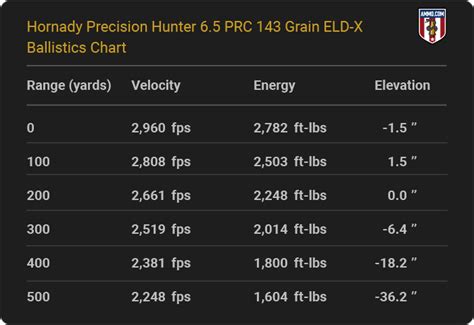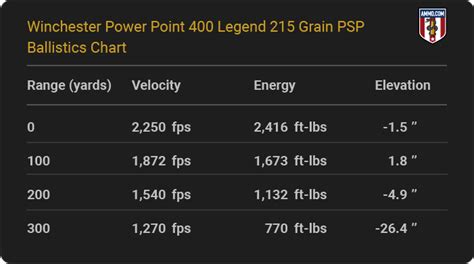Understanding the ballistics of the .300 PRC (Precision Rifle Cartridge) is crucial for any shooter looking to maximize the potential of this powerful round. The .300 PRC has gained popularity due to its exceptional performance and versatility, making it a top choice for long-range shooting enthusiasts. In this blog post, we will delve into the details of the .300 PRC ballistics chart, exploring its trajectory, energy, and performance at various distances.
Introduction to .300 PRC Ballistics

The .300 PRC cartridge was developed to provide shooters with a high-performance option for long-range precision shooting. With its impressive velocity and flat trajectory, it has become a go-to choice for hunters and competitive shooters alike. By examining the ballistics chart, we can gain insights into the cartridge's behavior and make informed decisions when selecting ammunition and setting up our rifles.
Understanding the Ballistics Chart

The .300 PRC ballistics chart provides valuable information about the cartridge's performance at different distances. It displays data such as muzzle velocity, trajectory, energy, and time of flight. By analyzing these factors, shooters can predict the bullet's path and make adjustments to their aim accordingly.
Here's a breakdown of the key parameters typically found in a .300 PRC ballistics chart:
- Muzzle Velocity: This refers to the initial velocity of the bullet as it leaves the barrel. It is a crucial factor in determining the overall performance of the cartridge.
- Trajectory: The trajectory represents the bullet's path as it travels through the air. It helps shooters understand the bullet's rise and fall at different distances.
- Energy: The energy column indicates the amount of kinetic energy the bullet possesses at various ranges. This information is essential for hunters when considering the terminal performance of the cartridge.
- Time of Flight: This parameter represents the time it takes for the bullet to reach a specific distance. It helps shooters calculate lead and anticipate the bullet's arrival.
Exploring the .300 PRC Ballistics Chart

Now, let's take a closer look at a sample .300 PRC ballistics chart to understand its practical implications. The following table provides data for a specific load and bullet type:
| Distance (yds) | Muzzle Velocity (fps) | Trajectory (in) | Energy (ft·lbs) | Time of Flight (s) |
|---|---|---|---|---|
| 100 | 3100 | 1.2 | 3100 | 0.23 |
| 200 | 3000 | 4.2 | 2800 | 0.46 |
| 300 | 2900 | 8.8 | 2500 | 0.69 |
| 400 | 2800 | 14.9 | 2200 | 0.92 |
| 500 | 2700 | 22.5 | 1900 | 1.15 |
| 600 | 2600 | 31.4 | 1600 | 1.38 |
| 700 | 2500 | 41.5 | 1300 | 1.61 |
| 800 | 2400 | 53.0 | 1100 | 1.84 |
| 900 | 2300 | 66.0 | 900 | 2.07 |
| 1000 | 2200 | 80.6 | 700 | 2.30 |

This ballistics chart illustrates the performance of the .300 PRC cartridge at various distances. As you can see, the muzzle velocity decreases gradually as the bullet travels, resulting in a flatter trajectory and consistent energy levels. This makes the .300 PRC an excellent choice for long-range shooting, as it maintains its accuracy and effectiveness over extended distances.
Factors Affecting Ballistics

Several factors can influence the ballistics of the .300 PRC cartridge. Understanding these factors is crucial for shooters to optimize their performance and achieve consistent results.
- Bullet Weight and Design: Different bullet weights and designs can impact the ballistics. Heavier bullets may have a lower initial velocity but maintain their energy and trajectory better at longer ranges. It's essential to choose the right bullet for your specific shooting needs.
- Barrel Length: The length of the rifle's barrel can affect muzzle velocity and overall performance. Longer barrels generally provide higher velocities, resulting in better long-range performance.
- Ambient Conditions: External factors such as temperature, humidity, and altitude can impact the ballistics. Shooters should be aware of these conditions and make appropriate adjustments to their aim.
- Rifle Setup: The accuracy and consistency of a rifle greatly influence the ballistics. Properly maintaining and tuning your rifle, including adjusting the scope and trigger, can significantly improve performance.
Tips for Maximizing .300 PRC Performance

To get the most out of your .300 PRC setup, consider the following tips:
- Choose a quality rifle with a suitable barrel length for your intended shooting distances.
- Select bullets that match your specific shooting requirements, whether it's for hunting or competition.
- Invest in a good-quality scope with advanced reticle options to aid in long-range shooting.
- Regularly practice and train to develop your shooting skills and build muscle memory.
- Experiment with different loads and ammunition to find the optimal combination for your rifle.
💡 Note: It's important to consult with experienced shooters or professionals to fine-tune your .300 PRC setup and maximize its potential.
Conclusion

The .300 PRC cartridge offers exceptional performance and versatility for long-range shooters. By understanding the ballistics chart and considering the factors that influence its performance, shooters can make informed decisions to achieve accurate and precise results. Whether you're a hunter or a competitive shooter, the .300 PRC is a powerful tool that can take your shooting skills to new heights.
FAQ

What is the recommended barrel length for a .300 PRC rifle?

+
A barrel length of 24 inches or longer is generally recommended for a .300 PRC rifle to achieve optimal performance. Longer barrels provide higher muzzle velocities and better long-range accuracy.
Can I use the .300 PRC cartridge for hunting?

+
Absolutely! The .300 PRC is an excellent choice for hunters due to its flat trajectory and high energy levels. It is suitable for taking down a wide range of game, from deer to larger animals, providing reliable performance at extended distances.
Are there any disadvantages to using the .300 PRC cartridge?

+
One potential disadvantage is the higher recoil compared to some other cartridges. However, with proper shooting technique and a well-designed rifle, the recoil can be managed effectively. Additionally, the cost of ammunition may be slightly higher due to its premium performance.
Can I reload my own .300 PRC ammunition?

+
Yes, reloading your own .300 PRC ammunition is possible and can be a cost-effective option for shooters. However, it requires knowledge and experience in reloading techniques, as well as access to the necessary equipment and components.